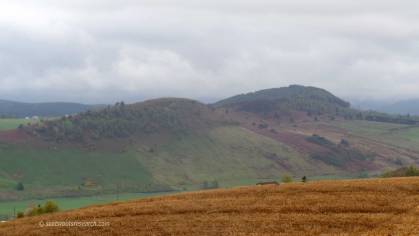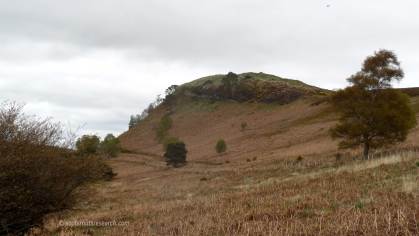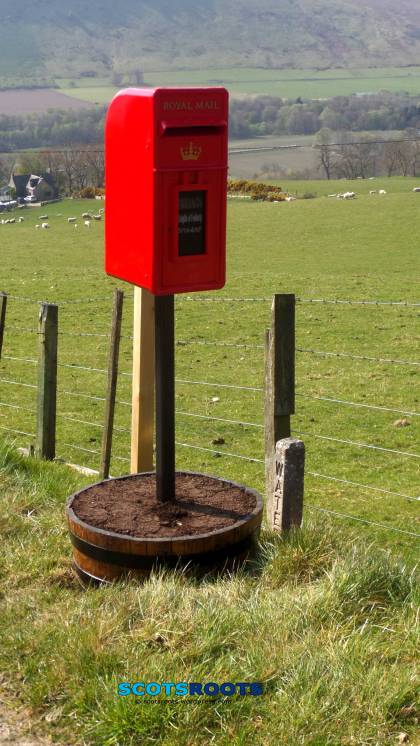 It’s amazing what you can grow in an old tub in the Highlands with a bit of tender loving care and some good peaty compost.
It’s amazing what you can grow in an old tub in the Highlands with a bit of tender loving care and some good peaty compost.
Filed under: Photographs, Scottish History | Tags: Knock Farril, Knockfarrel, Scottish Highlands
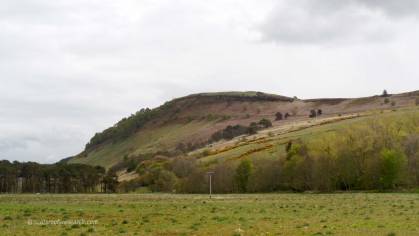 The hillfort of Knock Farril was the seat of an Iron Age chieftain or a Pictish king. It’s remains can be found on the summit of Knockfarrel hill near Dingwall to the north of Inverness.
The hillfort of Knock Farril was the seat of an Iron Age chieftain or a Pictish king. It’s remains can be found on the summit of Knockfarrel hill near Dingwall to the north of Inverness.
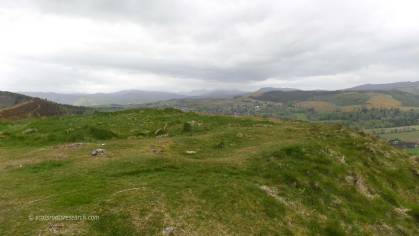 The summit is a wide grassy square surrounded by ditches and strange looking rocks with an almost glass-like appearance – the result of vitrification, a process whereby dry stone walls were subjected to intense heat which fused the stones together. It was once thought that vitrification was part of the building process but it is now more commonly believed to have been a process of destruction – where a conquered hillfort was destroyed by the victors.
The summit is a wide grassy square surrounded by ditches and strange looking rocks with an almost glass-like appearance – the result of vitrification, a process whereby dry stone walls were subjected to intense heat which fused the stones together. It was once thought that vitrification was part of the building process but it is now more commonly believed to have been a process of destruction – where a conquered hillfort was destroyed by the victors.
In the early 1770s the engineer John Williams conducted one of the earliest recorded archaeological excavations in Scotland here.
The views from the summit are spectacular in all directions.
Filed under: Photographs, Scottish History | Tags: Blackhouses, Hebrides, Scottish Highlands
 Blackhouses were traditionally built with thick dry stone walls, usually thatched with turf or reed and with floors of flagstones or packed earth.
Blackhouses were traditionally built with thick dry stone walls, usually thatched with turf or reed and with floors of flagstones or packed earth.
They were generally to be found in the Scottish Highlands, the Hebrides and Ireland.
Part of the house was used as living accommodation and part was used to keep livestock.
The house had no chimney and was heated by a fire in the middle of the floor, the smoke permeating out through the thatch.
Additional warmth was provided by the body heat of the animals living at the end of the house.
People continued to live in blackhouses into the twentieth century until the demand for more modern houses with better heating and plumbing caused them to fall out of favour.
Many have now been restored for use as holiday accommodation.
Filed under: Genealogy, Photographs, Scottish History | Tags: Achanlochy, Bettyhill, Boreraig, clan chiefs, clan system, cleared villages, Highland clearances, Poulouriskaig, Scots roots, Scottish ancestors, Scottish clearances, Scottish Highlands, Slettel, Suisnish
In the hundred years between 1760 and 1860, a whole race was largely dispossessed and dispersed, often in the name of ‘improvement’ and actively supported by the law and the church.
Unlike today, in the 18th century the Scottish Highlands were hugely over-populated. Many people lived in poverty on poor land that produced little. Rent was usually paid in kind or in service to the clan chief.
During the years following the Battle of Culloden in 1746, the clan system in the highlands of Scotland came under severe pressure. Much of the old way of life was banned by the government. Very few clansmen had taken part in the rebellion of 1745 but they were all punished. They were no longer allowed to wear tartan or to keep arms. The powers of the clan chiefs were diminished and they were forbidden to have their own armies.
Up until Culloden, a clan chief could count himself rich based on the number of men at his disposal. After Culloden, with the loss of his powers over the clan, his parental interest in his clansmen diminished and he needed paying tenants rather than soldiers.
 In the latter parts of the 18th century, chiefs started leasing their lands to graziers from the south – firstly to cattlemen and their black Highland cattle whose meat was required to feed a growing population, then, as Britain entered into long wars against the colonists in America and Napoleon in Europe, there was an even greater demand for meat and sheep were introduced to the Highland glens. These were not the scrawny sheep that the clansmen knew but black-faced Lintons and Cheviots which were hardy breeds that could live through the harsh Scottish winters and yielded more wool and mutton than their predecessors.
In the latter parts of the 18th century, chiefs started leasing their lands to graziers from the south – firstly to cattlemen and their black Highland cattle whose meat was required to feed a growing population, then, as Britain entered into long wars against the colonists in America and Napoleon in Europe, there was an even greater demand for meat and sheep were introduced to the Highland glens. These were not the scrawny sheep that the clansmen knew but black-faced Lintons and Cheviots which were hardy breeds that could live through the harsh Scottish winters and yielded more wool and mutton than their predecessors.
Lowland graziers looked for more and more land and the profits it would bring them and Highland lairds had debts to pay so, inevitably, the land was sold or leased to the graziers and the former tenants were forced to move.
Hundreds of small, uneconomic townships, each usually consisting of around half a dozen families, were cleared away, the confused inhabitants being packed off either to poor land around the coast or to a new life in Glasgow or the colonies.
Where resistance was met, special constables were drafted in and people were forcibly evicted. Houses were often burnt down or demolished after the tenants left to prevent their return. On some occasions, buildings were set alight before the tenants were out of the door.
When the Marquess of Stafford married Elizabeth, Countess of Sutherland in 1785 the whole of her estate in Sutherland became his and he and his wife set about making improvements to the land. Although this included the building of many roads and bridges it also led to the emptying of the glens by his factors and the introduction of thousands of sheep.
Some of the factors hired by the landlords – Patrick Sellar in Strathnaver and Donald Robertson in Strathglass, for example – leased some of the land from which they were evicting their employers’ tenants and became rich as sheep farmers themselves.
Many of the dispossessed left the country. At first this was mainly the young and healthy men. The rest – the aged, the infirm, women and children – were usually left to make what they could of their new lives on wasteland or by the sea.
Famine and disease followed dispossession and, in time, thousands rejected the poor land offered to them and emigrated to Nova Scotia, Canada or the Americas and later to Australia, many dying on the way.
 Between 1800 and 1803, 10,000 people left the Highlands for Nova Scotia and Canada. In 1831, 58,000 people left for Canada, 66,000 in 1832. In the years that followed, emigration to New South Wales gradually overtook emigration to Canada.
Between 1800 and 1803, 10,000 people left the Highlands for Nova Scotia and Canada. In 1831, 58,000 people left for Canada, 66,000 in 1832. In the years that followed, emigration to New South Wales gradually overtook emigration to Canada.
In 1851, the people of Knoydart were cleared straight on to a boat bound for Australia. They weren’t asked whether or not they wanted to go – their landlord wanted to avoid paying them poor relief.
The major periods of clearance were from around 1780 to 1820 and 1840 to 1854 but they continued throughout the 19th century until 1886 when the Crofters’ Holdings Act was passed by the government to give crofters security of tenure and other rights in response to social unrest.
The Scottish Highlands remain fairly empty to this day but the remains of many of the cleared villages can still be seen, often in some of the most beautiful parts of Scotland. We have visited a few of these on our trips around Scotland and more photographs can be viewed by clicking this link: Photos – Cleared Villages.
SCOTS ROOTS – CLEARED VILLAGES
The cleared villages shown in the photographs are:
BORERAIG AND SUISNISH, ISLE OF SKYE
32 families were cleared by the MacDonald’s ground officer in 1854 – mostly women and children, as the men and older boys were on the mainland working at the harvests to earn money to pay their rents. The women and children were evicted, furniture was thrown out and doors were barred. They were left to fend for themselves amongst the rocks through the cold autumn until the men came home – not that their lot improved much then.
ACHANLOCHY (‘the small field by the loch’), STRATHNAVER, SUTHERLAND
A village of around seven families, one of about fifty settlements in Stathnaver, it was cleared in 1819 and the land rented to John Paterson of Sandside as part of a sheepwalk. There is now very little to see but on close inspection you can still find the remains of dwellings, outbuildings and corn kilns, now mostly moss covered and overgrown.
POULOURISKAIG, SUTHERLAND
A village between Armadale to the east and Kirtomy to the west. It can be walked to from either direction but the best path in is from Armadale. The remains of several buildings and enclosures are clearly visible.
SLETELL, SUTHERLAND
A village to the north of Skullomie, near Tongue. A coastal walk with great views. Again, the remains of several buildings and enclosures are clearly visible.
BETTYHILL, SUTHERLAND
Not a cleared village but built by Elizabeth, Countess of Sutherland (and named after her) in the early 19th century to house some of the people cleared from Strathnaver.
If you have ancestors in Scotland and would like to know more about them, Scots Roots Research will gladly do the research for you and set it all out in an easy to follow report. Please click Scots Family History Research above for further details.
Copyright © Scots Roots Research 2012


